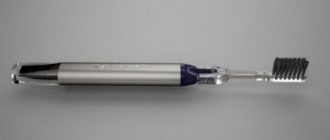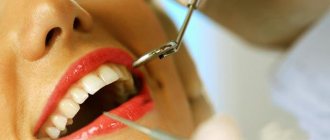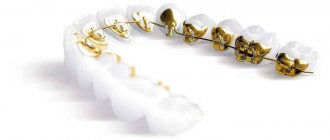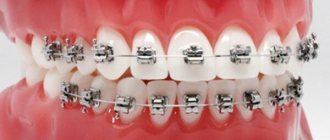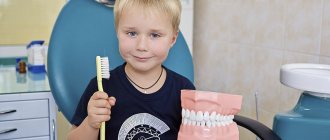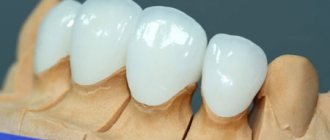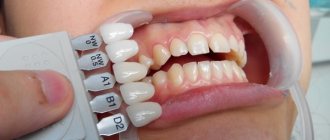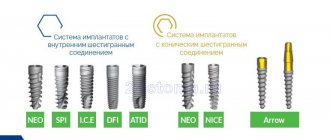08.04.2021 141
Few people really wonder how to choose a toothbrush. Often a person simply goes to the supermarket and chooses the first option he comes across. But this approach is fundamentally wrong.
The reason is that it is the brush that significantly influences the condition of the oral cavity, as well as a person’s risk of developing various diseases. Here are just a few of the potential problems that inattention to the selection process brings:
- Plaque will not be removed efficiently enough. This leads to bad breath, hard deposits, and gum inflammation.
- The gums will be damaged. This is a common consequence of using a brush with too stiff bristles.
- The enamel will be damaged. This is a relevant problem if you have thinning and other similar diseases.
Let's look at how to choose a toothbrush for an adult or a child, and focus on the main most significant parameters of such a hygienic accessory.
Pros and cons of hard toothbrushes
The main feature of hard toothbrushes is dense bristles with a larger diameter. The packaging of such a brush must indicate the degree of hardness: “hard”, “x-hard” or “extra hard”. Some products may have a combined type of bristles, where one area is harder and the other is softer. The soft-hard toothbrush option may be suitable for people who need enhanced dental hygiene but also have sensitive gums. A classic toothbrush for daily hygiene has three or four rows; a smaller number of tufts suggests highly specialized use, for example, for cleaning orthodontic structures.
Classification of toothbrushes by degree of hardness
The markings on the individual packaging of toothbrushes contain all the necessary information about the products, including the hardness (elasticity) of the bristles.
According to the characteristics of the bristles, there are the following types of dental brushes:
- ultra-soft toothbrush (sensitive) – provides the most delicate care for enamel and gums;
- soft brush (soft) – suitable for caring for children’s delicate enamel, and also provides gentle hygiene in case of increased tooth sensitivity;
- a brush with medium-hard bristles (medium) is the most common option, which is optimal for people who do not have pathologies in the oral cavity and serious dental abnormalities;
- hard toothbrush (hard) - effectively removes plaque, but is suitable for use only if the oral cavity is completely healthy, when both the enamel and gums are in perfect condition;
- a toothbrush of maximum hardness (extra-hard) - this option is used in rare cases and preferably only after mandatory consultation with a dentist.
When choosing a toothbrush, it is important to take into account all the features of the current state of the enamel and gums. This will ensure high-quality and safe hygiene, effectively remove plaque, perform a gentle massage of the soft tissues of the oral cavity and avoid unwanted injuries.
Types of toothbrushes with stiff bristles
By purpose:
- classic toothbrushes for daily hygiene, which include hard brushes with the “hard” index, however, products marked “x-hard” or “extra hard” are not recommended for use every day;
- therapeutic and prophylactic - designed to affect certain areas of the oral cavity, in particular, this includes brushes with combined bristles. Depending on the tasks, the type of working surface of the head with different levels of beam position is selected;
- highly specialized - designed for the care of dentures and orthodontic structures; this category includes hard toothbrushes labeled extra hard, which allow you to effectively remove plaque and deposits.
By type of action:
- classic mechanical;
- electric with a movable head, which is driven by an electric motor; you should use hard brush heads with extreme caution, as they can damage the enamel and gums more than classic brushes;
- sonic and ultrasonic, the bristles of which make oscillatory movements thanks to the built-in generator.
How to choose a toothbrush
11.10.2007
Using the wrong toothbrush can cause significant harm to your oral cavity. To make the right choice, it is necessary to take into account the clinical situation (the oral cavity is normal, the presence of gum disease, plaque, small or large interdental spaces, curvature, crowding of teeth, the presence of orthopedic, orthodontic structures) and the main characteristics of modern toothbrushes.
Using the wrong toothbrush can lead to microtrauma of the gums, damage to the enamel, and the development of stomatitis. To make the right choice, it is necessary to take into account the main characteristics of modern toothbrushes and the clinical condition of the oral cavity.
Bristle. Synthetic fibers are used (mainly nylon 612) with a diameter of 0.15-0.2 mm with rounded ends. According to the degree of hardness, toothbrushes are divided into very soft (sensitive; for children, as well as for adults with periodontal diseases and traumatic damage to hard dental tissues), soft (soft), medium hard (medium; most popular), hard (hard) and very hard (extra-hard; intended for people with an increased tendency to form plaque and deposits). Modern toothbrushes often combine bristles of different hardnesses. The bristles are collected in tufts, and the tufts are arranged in rows. Based on the nature of the arrangement of the beams, one-, two-, three- and multi-level brushes are distinguished. Based on the shape and location of the tufts (brush bed), hygienic, treatment-and-prophylactic and special brushes are distinguished.
Hygienic brushes have a flat brush field, low efficiency and are used relatively little.
Therapeutic and prophylactic brushes have a multi-level (usually two-level) brush field. Straight and high tufts remove plaque from the interdental spaces, short tufts remove plaque from the chewing surfaces of teeth, and oblique tufts remove plaque from the cervical area. At the front end there is often a large angled ridge (power ridge) that cleans the “sevens” and “eights” and provides deep penetration into the interdental spaces. The brush field may contain additional elements: rubber inserts of various types (for polishing the surfaces of teeth, soft massage of the gums), pads for cleaning the tongue (on the back side of the brush field; they remove plaque from the tongue and massage it), a color indicator (included in the bristles) and its change indicates the need to replace the toothbrush).
Special brushes (mono-beam, small-beam) are designed for cleaning teeth around orthopedic structures, uneven teeth, and for oral care with orthodontic structures and implants.
The design and size of the brush also plays an important role. The best brushes are those with rounded heads (less chance of damaging the oral mucosa), and with a tapered end (makes it easier to clean the distant chewing teeth). The handle of a modern brush has rubber inserts (to prevent slipping in the hand) and a special bend with thinning (to reduce pressure on the gums).
electric toothbrushes no more than 1-2 times a week. In electric brushes, the head and bristles vibrate at a sonic (250-500 Hz) or supersonic (1.6 MHz; so-called ultrasonic brushes) frequency. The effectiveness of the cleansing action of electric brushes is associated with the occurrence of microcirculation of fluid, due to which plaque is effectively removed. Ultrasonic brushes have the additional advantage of neutralizing bacteria even in subgingival areas under the influence of ultrasonic vibrations of a therapeutic frequency. Dual frequency electric brushes use a combination of two frequencies (sonic and ultrasonic frequency). The method of brushing teeth with electric brushes has specifics: the head is installed strictly perpendicular to the surface of the tooth, the head is moved slowly along the line of the adjacent gum (from tooth to tooth), each tooth is cleaned from the buccal, chewing and lingual surfaces, the applied pressure should not be greater (less than with a regular brush).
Choosing the right toothbrush depends on many factors. However, in general cases you can use the table as a guide.
| CLINICAL SITUATION | RECOMMENDATIONS (CHOICE OF BRUSH, CLEANING TECHNIQUE) |
| The oral cavity is normal | A regular hygiene brush or a treatment-and-prophylactic brush of medium hardness |
| Weak gums | A therapeutic and prophylactic brush with a multi-level brush field, a power protrusion, rubber inserts, or an ultrasonic brush (since it is necessary to massage the gums and clean the places where they contact the teeth) |
| Periodontitis, bleeding gums | A brush with one or two rows of bristles and a special teeth cleaning technique (brush at 45 degrees to the border between the tooth and the gum, short horizontal movements with the bristles deepening into the space between the gum and the tooth, the front teeth are brushed in a vertical direction) |
| Problems with tooth enamel | Brushes with minimal bristles and a flexible handle. Cleaning mainly with rotational movements, the front teeth - with vertical movements in the direction from the gum to the edge of the tooth |
| Plaque (including stained by drinking coffee, tea, tobacco), normal enamel condition | Brush with increased rigidity and multi-level brush field. Regular cleaning with an electric (ordinary or ultrasonic) brush is also advisable. |
| Small interdental spaces | A brush with a single-level brush field of sparsely spaced tufts inclined in opposite directions. Cleaning with vertical movements. Another option is a double-row brush with a narrow head (for cleaning the gingival philtrum and narrow grooves of the teeth with “sweeping” movements and, in addition, an electric (ultrasonic) brush. |
| Large interdental spaces | Brush with a medium or large head. Four-row multi-level brush field, additional rubber inserts |
| Crooked and crowded teeth | The most difficult situation. Small-tuft brushes are recommended, as well as electric, ultrasonic (with cone-shaped sharp bristles) or double-row brushes with a short narrow head (penetrates into hard-to-reach places) |
| Orthopedic, orthodontic structures in the oral cavity | Special oral care products are recommended. Cleaning around dentures is done with thin single-tuft brushes. In the case of metal-ceramic dentures and implants, electric toothbrushes can be used. In general, single-beam, small-beam and double-row brushes are recommended, as well as brushes with 2 brush fields (for cleaning different surfaces of the prosthesis). Special orthodontic brushes have a V-shaped groove in the center of the brush field |
| For children | Brushes (sensitive, soft) are chosen depending on age. For children under 2 years old, the brush should have a rubberized handle (designed for the parent’s hand), a small round head with a multi-level brush field, and be bright and elegant (to keep the child’s attention on the hygiene process). For children 2-5 years old, the brush should be small (adapted for a child’s hand) with a multi-level brush field and a small head (a power protrusion is allowed). Brushes should ensure cleansing of the mucous membranes and massage of the gums, especially during the eruption of the first temporary teeth and changing teeth. There are special finger-type toothbrushes for children from 3 months to 2 years (with soft bristles, put on the parents’ finger) |
Helpful information.
- You should change your toothbrush and electric brush heads once every 3 months. Mandatory replacement – after suffering from infectious diseases (to avoid re-infection and inflammation of the oral cavity).
- It is advisable to store toothbrushes in a special sterilizer for toothbrushes.
- Toothbrushes should only be purchased in specialized stores and pharmacies. According to statistics, approximately 50% of toothbrushes sold in Russia are fakes, the use of which can lead to damage and bleeding of the gums, and increased abrasion of the enamel.
In addition to toothbrushes, for proper teeth cleaning and oral hygiene, it is advisable to have an additional set of products at home: a set of various therapeutic and prophylactic toothpastes (with bioactive additives, mineral salts, for sensitive teeth, etc.), interdental brushes for cleaning interdental spaces , dental floss and toothpicks, interdental stimulators for massaging the gingival papillae (sometimes included in the design of toothbrushes), oral irrigators (devices with which a stream of water or an antiseptic solution under pressure cleans the interdental spaces, gum pockets, and massages the gums), means for cleaning the tongue (special brushes, pastes, etc.), rinses, elixirs for the oral cavity, balms for the gums.
Back to list
Posted in Useful information
Who should use a toothbrush with stiff bristles?
- Tendency to increased formation and mineralization of dental plaque.
- Crowded teeth and narrow interdental spaces.
- Having dentures or braces.
- Sensitive or damaged enamel.
- Periodontal inflammation and sensitive gums.
- The technique is not practiced in all clinics.
- Diabetes mellitus, poor blood clotting.
- Mobility of teeth.
- Wedge-shaped defect.
Attention!
The main danger of a toothbrush with hard bristles is damage to the enamel. This manifests itself in the form of reactions to cold and hot foods, as well as mechanical stress. Hard bristles can also be hard on your gums. On the other hand, the cleaning properties of a hard toothbrush are higher than those of soft analogues: if used correctly, it can effectively clean teeth from plaque.
What is a medium hardness device?
A model with medium bristles is suitable for adults who do not have problems with teeth and gums.
Its advantages include :
- effective teeth cleaning;
- removing plaque from the tongue and cheeks (if there is a special silicone insert);
- versatility. It is suitable for any type of enamel.
Medium hardness dental products are the most common and are available in a variety of brands.
Which stiff brush to choose?
When choosing any (including hard) toothbrush, you need to focus on trusted manufacturers and listen to the recommendations of an experienced dental hygienist. Quite high-quality and versatile products are produced by the Radius brand: the heads of these brushes have an unusual shape, which promotes better cleansing. Hard models are produced by CURAPROX, in particular for cleaning dentures and braces.
Many people are interested in the question of how to make a toothbrush hard? This is clearly not worth doing at home, since there is a high probability of ruining the toothbrush and your teeth. If your doctor recommended that you use a hard toothbrush for some time, you should purchase it at a specialized store rather than try to conduct experiments.
Other brush selection criteria
Once you have decided on the bristles, you should pay attention to other characteristics. There are different types of toothbrushes, which may differ in parameters such as:
- The tips of the bristles . The least traumatic ones are rounded. However, they do not clean well. Pointed ones are suitable for effective cleaning, including in the spaces between teeth. If you have problems with gingival blood circulation, we advise you to pay attention to options with blunt ends of the bristles.
- Pen . Do not use handles that are too short. Sufficient length allows you to regulate the degree of pressure on the teeth. It is also important that the design includes special rubber elements. They prevent the brush from slipping in wet hands.
- Head dimensions . This parameter directly affects how convenient it will be for you to use the device. For adults, the standard length is from 2.5 to 3 cm. For children, the sizes are smaller - 1.5-2 cm. A convenient option is a model with a movable head. It greatly facilitates the process of cleaning teeth in hard-to-reach places.
There are practically no special recommendations on how to choose a toothbrush for a child. You must first undergo an examination by a dentist to understand which type of bristle stiffness is suitable for your baby. Also keep in mind the head size requirements.
